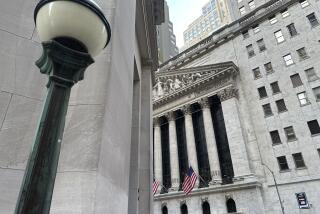Market Watch : Utilities’ Bond Message
- Share via
Have the utility stocks been telling us that it’s time to buy bonds?
Strong demand for utility shares often is a signal that investors believe that interest rates have peaked. That stems from investors’ treatment of utility stocks as proxies for bonds--because the stocks pay high dividend yields--and from the utilities’ historical sensitivity to borrowing costs.
Since Aug. 24, when the Dow Jones index of 15 utility stocks bottomed at 190.96, the utilities have been in a powerful uptrend--even while the Dow and most other market indexes continued to plunge.
Friday, the Dow utility index closed at 209.88, a 10% gain from Aug. 24. In contrast, the Dow industrials, at 2,520.79 Friday, are up just 1.5% from their Aug. 23 low. And the Dow is ahead only because of the 133-point rally last Thursday and Friday.
Andrew Addison, a technical analyst who writes the Addison Report from Franklin, Mass., argues that the utilities’ surge is a strong indication that interest rates are heading lower and that it’s time to lock in bond yields.
In fact, the bond market began rallying sharply late last week, as oil prices cracked. The yield on the 30-year Treasury bond closed at 8.76% Friday, down from 8.95% a week earlier. Since the Iraq-Kuwait crisis began in early August, the bond’s highest yield was 9.17% on Sept. 24.
Addison argues that “the bond market has had every excuse” in recent months to fall apart, including the dive in the dollar and major competition from high interest rates in Japan and Germany. The fact that the yield on the 30-year Treasury bond could climb no higher than 9.17%, he says, “is telling you that the positive influence (on interest rates) of a weaker economy is stronger than the negative influence of higher rates abroad.”
The utility stocks are confirming that, Addison says. He sees the yield on the 30-year bond falling another half-percentage point by year-end, to around 8.3%.
But other analysts warn against trusting the utilities to point the way to lower interest rates soon, or to a broad stock market rally ahead. Jonathan Dodd, technical analyst at Dean Witter Reynolds in New York, notes that one of the strongest components of the Dow utility index has been the natural gas group, including Columbia Gas and Consolidated Natural Gas. They are expected to benefit from the surge in oil prices--and, as such, those stocks represent a direct bet on higher inflation, which is bad for bonds and most other stocks.
Also, he notes, utility stocks in general often provide a “defensive” holding for money managers, meaning they’re stocks you buy when you expect that other investments are on the verge of crumbling to bits.
Bill Corneliuson, who manages the $213-million Strong Investment mutual fund in Milwaukee, suggests that investors take a cautious approach toward locking in bond yields, even though he admits there’s a good chance that rates will slide as the economy continues to drop into recession.
Corneliuson’s fund takes a “balanced” approach toward investing, shifting money among stocks, bonds and cash investments depending on the attractiveness of each. Through Oct. 11, his fund was the top-ranked balanced fund year-to-date: The fund has managed to stay even, while the average balanced fund has lost more than 6% of its value, according to Lipper Analytical Services Inc.
The Strong Investment fund now is 52% in cash, 15% in high-quality stocks and 33% in Treasury securities that have an average maturity of four years, Corneliuson says. Chances are he’ll siphon more of his cash into bonds over time, he says. But he advises waiting to buy on weakness in the market. For example, when the Treasury attempts to sell a massive new slate of bonds in November, Corneliuson expects yields to jump again, presenting attractive opportunities. Better to be patient, he says.
“Any time you get over 9% (on bonds), that’s going to be close to the high end of the yield range” for some time to come, he says.
Briefly: L.A. brokerage Bateman Eichler, Hill Richards has lost medical technology analyst Steven Gerber to Oppenheimer & Co., where he’ll cover the mainstream drug companies. He is Oppenheimer’s first L.A.-based analyst (the rest are in New York). Meanwhile, Bateman last week hired Chris Kirby, ex of Rothschild Inc., to cover computer software and other technology stocks. The hire may dispel rumors that Bateman parent Kemper Corp. is looking to slash analyst staffs at its regional brokerages, which besides Bateman include Boettcher & Co. in Denver and Prescott, Ball & Turben in Cleveland. . . .
Maybe the bears are wrong after all. Fashions for spring and summer 1991, on display now in Italy, herald a return to the miniskirts and hot pants of the 1960s. Remember the old saying: Stock prices follow hemlines. . . .
More to Read
Inside the business of entertainment
The Wide Shot brings you news, analysis and insights on everything from streaming wars to production — and what it all means for the future.
You may occasionally receive promotional content from the Los Angeles Times.










